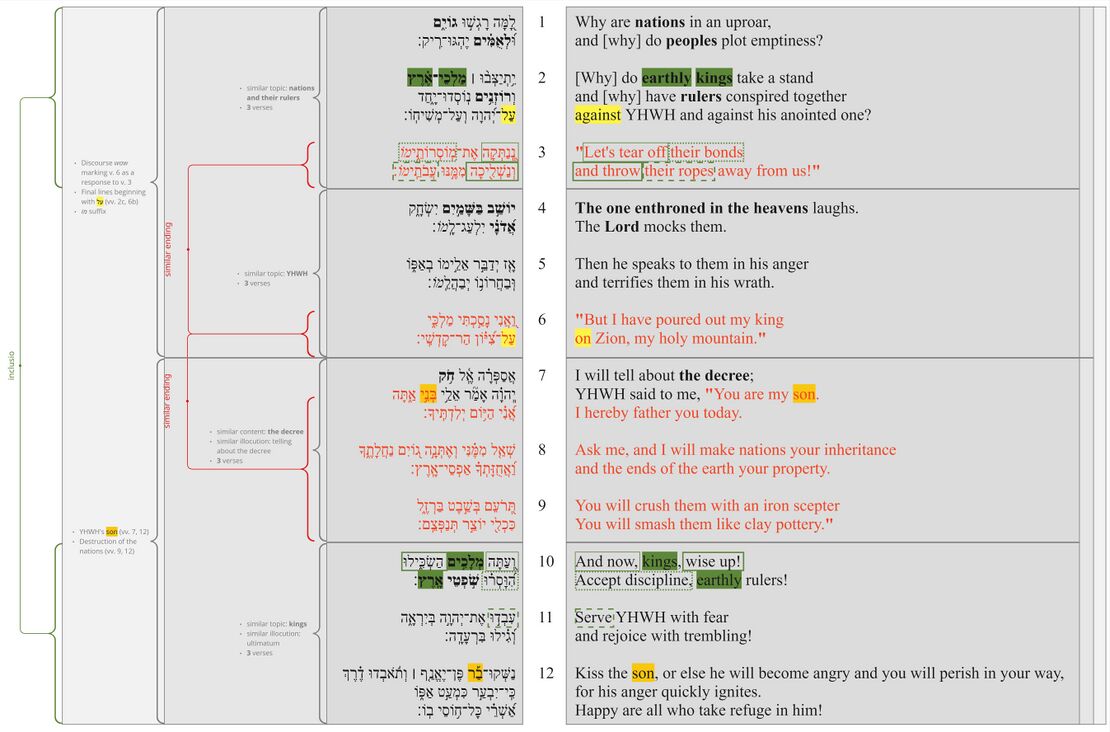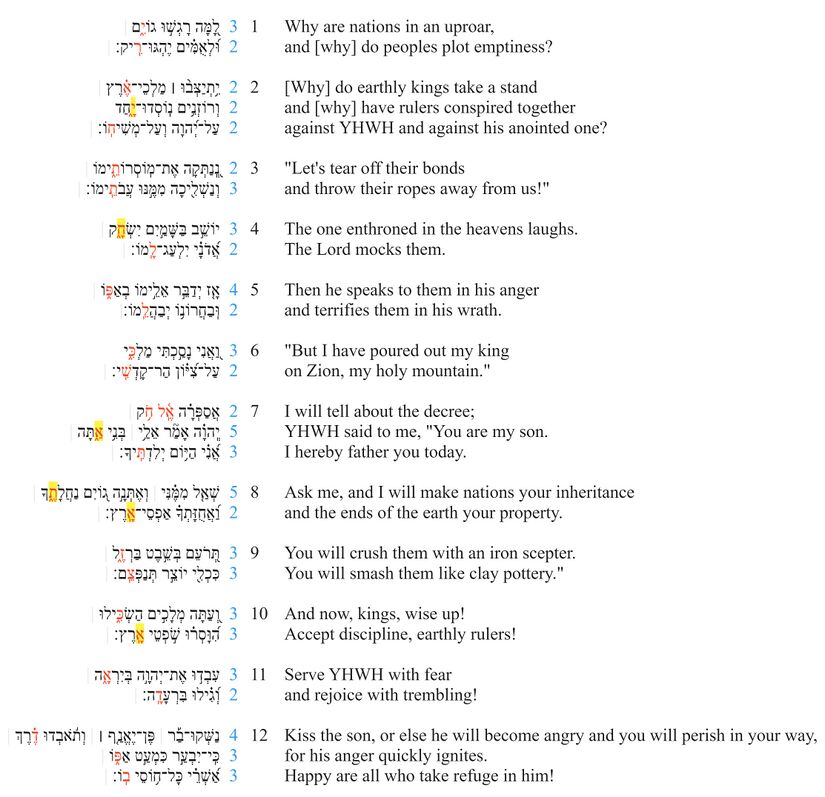Psalm 2 Poetic Structure
Poetic Structure
In poetic structure, we analyse the structure of the psalm beginning at the most basic level of the structure: the line (also known as the “colon” or “hemistich”). Then, based on the perception of patterned similarities (and on the assumption that the whole psalm is structured hierarchically), we argue for the grouping of lines into verses, verses into sub-sections, sub-sections into larger sections, etc. Because patterned similarities might be of various kinds (syntactic, semantic, pragmatic, sonic) the analysis of poetic structure draws on all of the previous layers (especially the Discourse layer).
Poetic Macro-structure
If an emendation or revocalization is preferred, that emendation or revocalization will be marked in the Hebrew text of all the visuals.
| Emendations/Revocalizations legend | |
|---|---|
| *Emended text* | Emended text, text in which the consonants differ from the consonants of the Masoretic text, is indicated by blue asterisks on either side of the emendation. |
| *Revocalized text* | Revocalized text, text in which only the vowels differ from the vowels of the Masoretic text, is indicated by purple asterisks on either side of the revocalization. |
| v. 1 Why are nations in an uproar, and [why] do peoples plot emptiness? | Rebellion | Why do the earthly kings rebel against YHWH and his king? | contempt | |
| v. 2 [Why] do earthly kings take a stand and [why] have rulers conspired together against YHWH and against his anointed one? | ||||
| v. 3 Let's tear off their bonds and throw their ropes away from us! | ||||
| v. 4 The one enthroned in the heavens laughs. The Lord mocks them. | Response | The heavenly king laughs | contempt & awe | |
| v. 5 Then he speaks to them in his anger and terrifies them in his wrath. | ||||
| v. 6 But I have poured out my king on Zion, my holy mountain. | ||||
| v. 7 I will tell about the decree; YHWH said to me, "You are my son. I hereby father you today. | Decree | I, the king on YHWH's mountain, will tell about YHWH's decree | confidence | |
| v. 8 Ask me, and I will make nations your inheritance and the ends of the earth your property. | ||||
| v. 9 You will crush them with an iron scepter. You will smash them like clay pottery. | ||||
| v. 10 And now, kings, wise up! Accept discipline, earthly rulers! | Ultimatum | Wise up, earthly kings! Serve YHWH... Kiss the son! | contempt | |
| v. 11 Serve YHWH with fear and rejoice with trembling! | ||||
| v. 12 Kiss the son, or else he will become angry and you will perish in your way, for his anger quickly ignites. Happy are all who take refuge in him! |
Notes
Psalm 2 has four sections: vv. 1-3; vv. 4-6; vv. 7-9; vv. 10-12. This division is widely accepted. As van der Lugt notes, "The division is so obvious that there is no discussion among scholars about this fact."[1] The main reasons for the four-fold division are as follows:
- Content, discourse topic, illocution. The first section describes the futile rebellion of the earthly nations and their rulers (vv. 1-3); the second section describes the response of YHWH, the Lord enthroned in heaven (vv. 4-6); the third section tells about the decree (vv. 7-9); and the fourth section warns and exhorts the earthly kings (vv. 10-12). The topic of each section is mentioned in the first line of that section (bolded in the visual above). See further Macrosyntax and Speech Act Analysis.
- Similar endings. Each of the first three sections ends with quoted speech. The two-line speech of the nations concludes the first section (v. 3); YHWH's two-line speech in response to the nations concludes the second section (v. 6); and YHWH's seven-clause decree concludes (and constitutes the bulk of) the third section (vv. 7-9). The fact that there is no direct speech concluding the final section might be a poetic feature: how will the nations respond? See further Poetic Features.
- Balance. Each section is three verses long.
These four sections are connected in multiple ways, such that multiple patterns emerge. For example,
- ABBA.
- A...A: There are clear connections between the first and last sections (vv. 1-3 // vv. 10-12),[2] indicating an ABBA chiastic structure.
- Sections 1 and 4 are both about the earthly kings, and both sections use the words "kings" and "earth" (v. 2, v. 10).
- There is a clear thematic reversal: vv. 1-3 describe the nations' rebellion against YHWH and against his anointed, and vv. 10-12 summon the nations to submit to YHWH and his anointed.[3]
- Numerous sound correspondences connect the speech of the kings in v. 3 with the warning to the kings in v. 10. See Poetic Features.
- BB: There is also continuity between the middle sections (vv. 4-6 // vv. 7-9). Both sections present YHWH's speaking to legitimate his king's right to rule.[4]
- Of the various patterns identified here, this pattern (ABBA) brings out the inner logic of the psalm most powerfully in the way it highlights the reversal of the earthly kings in vv. 1-3, 10-12.
- A...A: There are clear connections between the first and last sections (vv. 1-3 // vv. 10-12),[2] indicating an ABBA chiastic structure.
- AABB. In addition to the chiastic structure, there are ways in which the psalm divides into two halves (vv. 1-6; vv. 7-12).
- AA: Some features bind together vv. 1-6.
- The first two sections (vv. 1-3; vv. 4-6) are bound together by their similar endings (vv. 3, 6). Both sections end with quoted speech that is two lines long and not introduced by any quotative frame.[5] Furthermore, the waw beginning the speech in v. 6 explicitly connects this speech to the speech in v. 3. See Macrosyntax.
- The similarity between v. 2c and v. 6c is striking. Both lines begin with the preposition עַל and continue the clause of the previous line: "...against (עַל) YHWH and against (עַל) his anointed one" (v. 2c) // "...on (עַל) Zion, my holy mountain" (v. 6b).
- The repetition of the sound o and, specifically, the suffix מוֹ at the ends of lines (vv. 3a, 3b, 4b, 5b).[6]
- BB: Some features bind together vv. 7-12.
- Both sections mention the "son" (vv. 7b [בן], 12a [בר]).
- Both sections describe the potential destruction of the nations and their kings (vv. 9, 12).
- AA: Some features bind together vv. 1-6.
- ABAB. There are also correspondences between the first and third sections and between the second and fourth sections.[7] E.g.,
- A...A: "nations" (vv. 1a, 8a), "earth" (vv. 2a, 8b), מִן "from" (vv. 3b, 8a)
- B...B: "his anger" (vv. 5a, 12b)
Line Divisions
Line division divides the poem into lines and line groupings. We determine line divisions based on a combination of external evidence (Masoretic accents, pausal forms, manuscripts) and internal evidence (syntax, prosodic word counting and patterned relation to other lines). Moreover, we indicate line-groupings by using additional spacing.
When line divisions are uncertain, we consult some of the many psalms manuscripts which lay out the text in lines. Then, if a division attested in one of these manuscripts/versions influences our decision to divide the text at a certain point, we place a green symbol (G, DSS, or MT) to the left of the line in question.
| Poetic line division legend | |
|---|---|
| Pausal form | Pausal forms are highlighted in yellow. |
| Accent which typically corresponds to line division | Accents which typically correspond to line divisions are indicated by red text. |
| | | Clause boundaries are indicated by a light gray vertical line in between clauses. |
| G | Line divisions that follow Greek manuscripts are indicated by a bold green G. |
| DSS | Line divisions that follow the Dead Sea Scrolls are indicated by a bold green DSS. |
| M | Line divisions that follow Masoretic manuscripts are indicated by a bold green M. |
| Number of prosodic words | The number of prosodic words are indicated in blue text. |
| Prosodic words greater than 5 | The number of prosodic words if greater than 5 is indicated by bold blue text. |
If an emendation or revocalization is preferred, that emendation or revocalization will be marked in the Hebrew text of all the visuals.
| Emendations/Revocalizations legend | |
|---|---|
| *Emended text* | Emended text, text in which the consonants differ from the consonants of the Masoretic text, is indicated by blue asterisks on either side of the emendation. |
| *Revocalized text* | Revocalized text, text in which only the vowels differ from the vowels of the Masoretic text, is indicated by purple asterisks on either side of the revocalization. |
Notes
- All line divisions in the psalm agree with the Masoretic accents as interpreted by de Hoop and Sanders 2022, §6.2. The divisions in vv. 1-11 agree also with the Septuagint according to Rahlfs (1931). (Note, however, that Rahlfs' division of v. 1 goes against most LXX witnesses, which present v. 1 as a single stich.)
- The line division of v. 12, specifically the first half of v. 12, is difficult to determine. At least four different divisions would be plausible:
- One line, following the accents (?)

- Two lines, following the LXX

- Two lines, following the syntax

- Two lines, grouping v. 12a with v. 11b[8]

- One line, following the accents (?)
- The Septuagint's division appears to work against the syntax, according to which פֶּן־יֶאֱנַ֤ף ׀ and וְתֹ֬אבְדוּ דֶ֗רֶךְ are coordinate clauses within the scope of the same subordinating conjunction פֶּן. (The Septuagint's division might also be influenced by the addition of a word at the end of the clause: καὶ ἀπολεῖσθε ἐξ ὁδοῦ δικαίας).
- We could keep the two subordinate clauses together and divide instead after בַ֡ר, but this would result in a very short line: נַשְּׁקוּ־בַ֡ר (one prosodic word, four syllables), which would be the shortest line in the psalm. If, however, we do not divide at all—נַשְּׁקוּ־בַ֡ר פֶּן־יֶאֱנַ֤ף ׀ וְתֹ֬אבְדוּ דֶ֗רֶךְ—, then v. 12a would be the longest line in the psalm (12-14 syllables, depending on how they are counted). In either case, the beginning of v. 12 is marked in terms of its prosodic structure.
- In the end, we have followed the Masoretic accents in dividing v. 12. Jerome (iuxta Hebr.) appears to follow the same division (see Weber-Gryson 5th edition).







